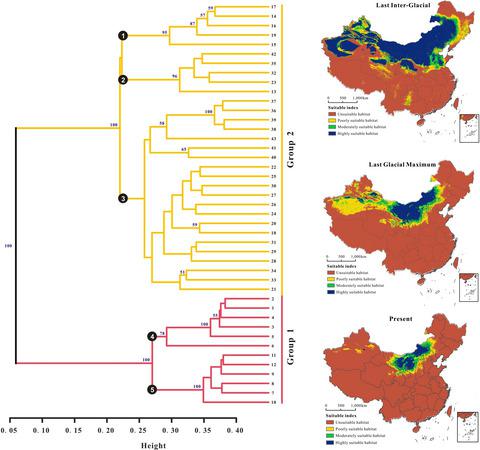当前位置:
X-MOL 学术
›
Ecol. Evol.
›
论文详情
Our official English website, www.x-mol.net, welcomes your feedback! (Note: you will need to create a separate account there.)
Population genetic structure and evolutionary history of Psammochloa villosa (Trin.) Bor (Poaceae) revealed by AFLP marker
Ecology and Evolution ( IF 2.6 ) Pub Date : 2021-07-13 , DOI: 10.1002/ece3.7831 Ting Lv 1, 2 , A J Harris 3 , Yuping Liu 2, 4 , Tao Liu 1 , Ruifang Liang 4 , Zilan Ma 4 , Xu Su 1, 2, 4, 5
Ecology and Evolution ( IF 2.6 ) Pub Date : 2021-07-13 , DOI: 10.1002/ece3.7831 Ting Lv 1, 2 , A J Harris 3 , Yuping Liu 2, 4 , Tao Liu 1 , Ruifang Liang 4 , Zilan Ma 4 , Xu Su 1, 2, 4, 5
Affiliation

|
Psammochloa villosa is an ecologically important desert grass that occurs in the Inner Mongolian Plateau where it is frequently the dominant species and is involved in sand stabilization and wind breaking. We sought to generate a preliminary demographic framework for P. villosa to support the future studies of this species, its conservation, and sustainable utilization. To accomplish this, we characterized the genetic diversity and structure of 210 individuals from 43 natural populations of P. villosa using amplified fragment length polymorphism (AFLP) markers. We obtained 1,728 well-defined amplified bands from eight pairs of primers, of which 1,654 bands (95.7%) were polymorphic. Results obtained from the AFLPs suggested effective alleles among populations of 1.32, a Nei's standard genetic distance value of 0.206, a Shannon index of 0.332, a coefficient of gene differentiation (GST) of 0.469, and a gene flow parameter (Nm) of 0.576. All these values indicate that there is abundant genetic diversity in P. villosa, but limited gene flow. An analysis of molecular variance (AMOVA) showed that genetic variation mainly exists within populations (64.2%), and we found that the most genetically similar populations were often not geographically adjacent. Thus, this suggests that the mechanisms of gene flow are surprisingly complex in this species and may occur over long distances. In addition, we predicted the distribution dynamics of P. villosa based on the spatial distribution modeling and found that its range has contracted continuously since the last interglacial period. We speculate that dry, cold climates have been critical in determining the geographic distribution of P. villosa during the Quaternary period. Our study provides new insights into the population genetics and evolutionary history of P. villosa in the Inner Mongolian Plateau and provides a resource that can be used to design in situ conservation actions and prioritize sustainable utilization.
中文翻译:

AFLP标记揭示的Psammochloa villosa (Trin.) Bor (Poaceae)种群遗传结构和进化史
Psammochloa villosa是一种生态重要的沙漠草,生长于内蒙古高原,经常是优势种,参与固沙和防风。我们试图为P. villosa生成一个初步的人口统计框架,以支持对该物种、其保护和可持续利用的未来研究。为了实现这一点,我们对来自P. villosa 的43 个自然种群的 210 个个体的遗传多样性和结构进行了表征使用扩增片段长度多态性 (AFLP) 标记。我们从八对引物中获得了 1,728 个明确的扩增条带,其中 1,654 个条带 (95.7%) 是多态的。从 AFLP 获得的结果表明,种群中的有效等位基因为 1.32,Nei 的标准遗传距离值为 0.206,香农指数为 0.332,基因分化系数 ( G ST ) 为 0.469,基因流参数 ( N m) 为0.576。所有这些值表明P. villosa具有丰富的遗传多样性,但基因流有限。分子方差分析(AMOVA)表明遗传变异主要存在于种群内(64.2%),我们发现遗传最相似的种群往往在地理上并不相邻。因此,这表明该物种的基因流动机制出奇地复杂,并且可能发生在长距离内。此外,我们基于空间分布模型预测了P. villosa的分布动态,发现自上次间冰期以来,其分布范围不断缩小。我们推测干燥、寒冷的气候对于决定P. villosa的地理分布至关重要在第四纪期间。我们的研究为内蒙古高原绒毛松的种群遗传学和进化历史提供了新的见解,并提供了可用于设计就地保护行动和优先考虑可持续利用的资源。
更新日期:2021-08-03
中文翻译:

AFLP标记揭示的Psammochloa villosa (Trin.) Bor (Poaceae)种群遗传结构和进化史
Psammochloa villosa是一种生态重要的沙漠草,生长于内蒙古高原,经常是优势种,参与固沙和防风。我们试图为P. villosa生成一个初步的人口统计框架,以支持对该物种、其保护和可持续利用的未来研究。为了实现这一点,我们对来自P. villosa 的43 个自然种群的 210 个个体的遗传多样性和结构进行了表征使用扩增片段长度多态性 (AFLP) 标记。我们从八对引物中获得了 1,728 个明确的扩增条带,其中 1,654 个条带 (95.7%) 是多态的。从 AFLP 获得的结果表明,种群中的有效等位基因为 1.32,Nei 的标准遗传距离值为 0.206,香农指数为 0.332,基因分化系数 ( G ST ) 为 0.469,基因流参数 ( N m) 为0.576。所有这些值表明P. villosa具有丰富的遗传多样性,但基因流有限。分子方差分析(AMOVA)表明遗传变异主要存在于种群内(64.2%),我们发现遗传最相似的种群往往在地理上并不相邻。因此,这表明该物种的基因流动机制出奇地复杂,并且可能发生在长距离内。此外,我们基于空间分布模型预测了P. villosa的分布动态,发现自上次间冰期以来,其分布范围不断缩小。我们推测干燥、寒冷的气候对于决定P. villosa的地理分布至关重要在第四纪期间。我们的研究为内蒙古高原绒毛松的种群遗传学和进化历史提供了新的见解,并提供了可用于设计就地保护行动和优先考虑可持续利用的资源。



























 京公网安备 11010802027423号
京公网安备 11010802027423号